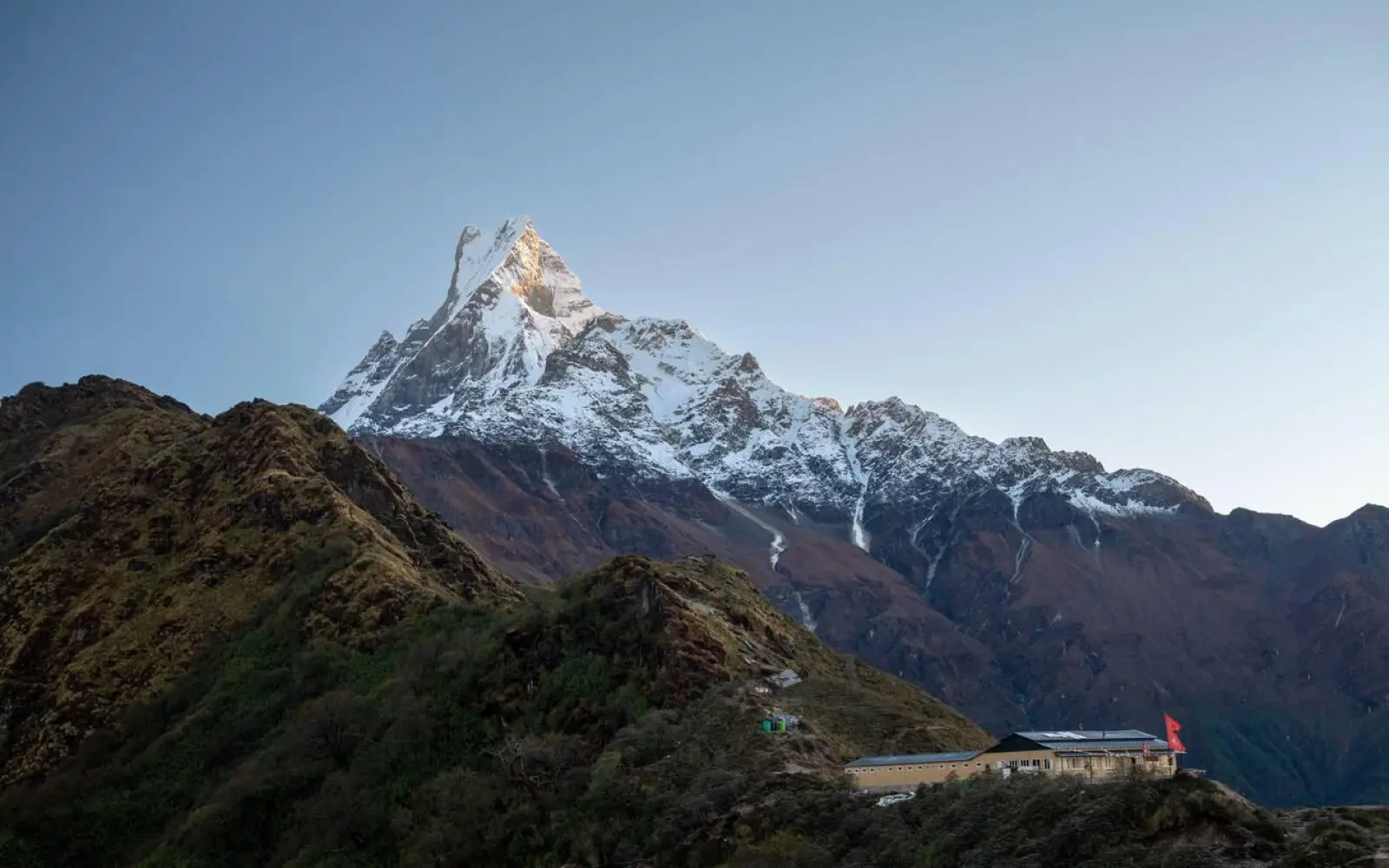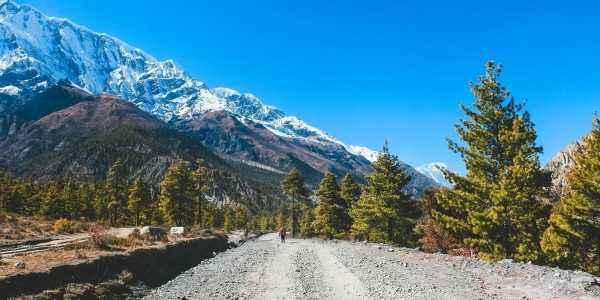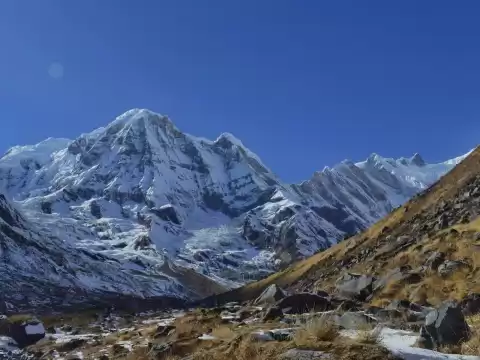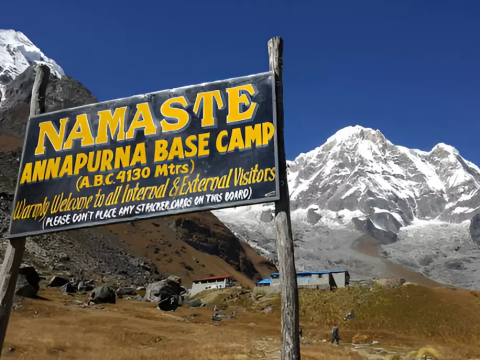Annapurna Circuit Trek 2022/2023- Ultimate Travel Guide
The Annapurna Circuit trek is a majestic trekking route in Nepal that carries a huge legacy. The Ann...

Trekking the Mardi Himal is a rewarding adventure that offers stunning views of the Annapurna mountain range, dense rhododendron forests, and authentic village experiences. This trek is perfect for those who want to experience the Himalayas without the crowds of more popular routes like Annapurna Base Camp or Everest Base Camp. Our budget-friendly itinerary spans five days and balances trekking with comfort, making it accessible for beginners and seasoned trekkers alike.
The Mardi Himal trek is relatively new on the trekking map, which means fewer tourists and pristine natural beauty. The route combines moderate altitude gain with manageable hiking distances, ideal for those looking for an immersive Himalayan experience without spending too much. Our expert guides from Himalayan Forever Treks will help you navigate this trail safely while making the journey both enjoyable and affordable.
In this guide, you’ll find detailed day-by-day plans, insights into the best times to visit, what to pack on a budget, and how to manage trekking permits and costs effectively. Whether you’re a solo traveler, a couple, or a small group, this itinerary is tailored to give you the best experience in the Mardi Himal region without breaking the bank.
Quick Overview:
Trekking Mardi Himal offers a unique blend of adventure, culture, and natural beauty. Unlike the busier Annapurna Base Camp trek, Mardi Himal remains off the beaten path, allowing trekkers to enjoy quieter trails and untouched landscapes. The highlight is the panoramic view of iconic Himalayan peaks such as Machhapuchhre (Fishtail), Annapurna South, and Hiunchuli, making it a photographer’s paradise. The trail weaves through lush forests, quaint villages, and alpine meadows filled with colorful flora, providing a rich trekking experience.
One of the main reasons this trek is budget-friendly is the availability of affordable teahouses and lodges along the route. Unlike commercial trekking routes with fixed-price accommodation, Mardi Himal offers competitive lodging options where you can enjoy comfortable stays without the hefty price tag. The proximity of the trek to Pokhara, a well-connected city, keeps transportation costs low. Moreover, the trek can be completed in fewer days, reducing overall expenses related to food, lodging, and permits.
Another factor contributing to the affordability is the possibility to self-organize the trek or choose local guiding companies like Himalayan Forever Treks, which offer competitive rates without compromising on safety and quality. This trek suits solo travelers, budget backpackers, and small groups aiming for a rewarding Himalayan adventure at a lower cost.
Key Points:
Best Time to Go:
The ideal time to trek Mardi Himal is during the pre-monsoon (March to May) and post-monsoon (September to November) seasons. These periods offer the clearest mountain views, moderate temperatures, and relatively dry trails. Spring is especially beautiful due to blooming rhododendrons, while autumn boasts stable weather and crisp air. Winter treks are possible but cold, and the monsoon season brings heavy rain, making trails slippery and less enjoyable.
Permits and Costs:
To trek Mardi Himal, you will need the Annapurna Conservation Area Permit (ACAP) and a Trekkers’ Information Management System (TIMS) card. The ACAP permit costs around $30 USD, and the TIMS card is approximately $20 USD for independent trekkers (less if you book through a registered agency). These fees contribute to conservation and safety efforts in the region. Accommodation and food costs vary but budget options typically range from $5 to $15 per night for lodging and $3 to $7 per meal.
Budget Packing List:
Packing smart is essential for a budget trek. Prioritize lightweight and multifunctional gear such as:
Bringing your own gear saves money on rentals, and buying local food and lodging helps support the community while keeping your costs low.
Summary:
Pokhara, the gateway to Mardi Himal Trek, is a vibrant city known for its stunning lakeside views and spectacular mountain panoramas. It’s well connected by both air and road, making it easy to reach from Kathmandu and other major cities in Nepal. The fastest and most popular way to get to Pokhara is by taking a domestic flight from Kathmandu, which takes around 25-30 minutes and offers spectacular aerial views of the Himalayas. Alternatively, many travelers prefer the scenic but longer bus ride from Kathmandu to Pokhara, which lasts about 6-8 hours, passing through beautiful valleys and traditional villages.
Transportation to Kande (Trek Start Point)
Once in Pokhara, reaching the trek starting point at Kande is straightforward. Kande is approximately a 1.5-hour drive from the city, accessible by local buses, private jeeps, or taxis. Himalayan Forever Treks offers organized transportation services, ensuring a hassle-free start to your trekking adventure. The drive to Kande takes you through rolling hills, rural villages, and verdant farmland, offering a taste of Nepal’s diverse landscapes even before the trek begins.
Choosing local buses is the most budget-friendly option, although it may take longer and be less comfortable. Private jeeps or taxis provide faster, more comfortable travel but at a higher cost. Regardless of your choice, the journey to Kande is a scenic introduction to the Mardi Himal region and the perfect way to acclimatize to the slower pace of trekking life.
Key Points:
Day 1: Drive from Pokhara to Kande (1,770m) and Trek to Forest Camp (2,550m)
Your Mardi Himal trekking adventure kicks off with a scenic drive from the lakeside city of Pokhara to Kande. This approximately 1.5-hour drive winds through beautiful hills and villages, offering a preview of the stunning landscapes to come. Upon arrival in Kande, you’ll prepare your gear for the trek and begin your hike on well-marked trails that ascend gradually. The air is fresh, and the trail meanders through terraced fields and lush forests, providing a peaceful start to your journey.
As you ascend from 1,770 meters to 2,550 meters, you’ll notice the change in vegetation, moving from subtropical greenery to dense rhododendron and oak forests. The hike typically takes 4 to 5 hours, with some short breaks to enjoy panoramic views and interact with local villagers. At Forest Camp, the lodges are basic but cozy, offering warm meals and friendly hospitality—perfect for relaxing and recharging after your first day. This relatively moderate climb helps your body begin to acclimatize while letting you soak in the natural beauty of the Annapurna region.
Day 1 Summary:
Day 2: Trek from Forest Camp to Low Camp (2,970m)
Day 2 begins with a gradual climb from Forest Camp to Low Camp, covering approximately 5 to 6 hours on the trail. The path leaves the dense forests behind, opening into beautiful alpine meadows dotted with wildflowers and offering expansive views of towering Himalayan peaks such as Machhapuchhre (Fishtail) and Annapurna South. This day is more challenging than the first, with steeper sections that test your stamina but reward you with breathtaking scenery.
Along the way, you’ll pass small mountain settlements where local Sherpa and Gurung communities welcome trekkers with traditional smiles and hearty meals. The teahouses at Low Camp are simple but comfortable, providing warm rooms and nutritious food to refuel your energy. At 2,970 meters, Low Camp serves as a great spot for acclimatization, with crisp mountain air and beautiful sunset vistas. This stage of the trek deepens your connection with the Himalayan environment while preparing you for higher altitudes ahead.
Day 2 Summary:
Day 3: Trek from Low Camp to High Camp (3,580m)
On Day 3, you’ll tackle one of the most physically demanding legs of the trek: ascending from Low Camp to High Camp. The trail climbs sharply over approximately 4 to 5 hours, winding through alpine terrain that becomes increasingly rocky and exposed. The thinner air and steep sections require a steady pace and regular breaks. However, the spectacular panoramic views of the Annapurna range make every step worthwhile.
High Camp, situated at 3,580 meters, is nestled beneath Mardi Himal itself, surrounded by rugged peaks and sweeping valleys. The lodges here are basic but welcoming, offering hearty meals to help you regain energy. Staying overnight at High Camp is essential to prepare your body for the next day’s summit attempt to Mardi Himal Base Camp. The crisp mountain air and starry nights here create an unforgettable alpine experience, making this day a highlight of the trek.
Day 3 Summary:
Day 4: Hike to Mardi Himal Base Camp (4,500m) and Return to High Camp, then Descend to Low Camp
Day 4 is the highlight of the Mardi Himal trek: the ascent to Mardi Himal Base Camp at 4,500 meters. Starting early in the morning, you’ll embark on a 3 to 4-hour hike through dramatic alpine landscapes. The trail is steep and rocky but offers unparalleled views of towering peaks such as Annapurna I, Hiunchuli, and the iconic Machhapuchhre. Reaching the Base Camp rewards you with a sense of achievement and panoramic 360-degree views that are truly breathtaking.
After spending some time at Base Camp to soak in the scenery and capture photos, you’ll return to High Camp for a brief rest. From there, the descent begins toward Low Camp, allowing your body to recover from the high-altitude exertion. Descending can be easier physically but requires careful footing to avoid slips. The day’s journey totals about 7 to 9 hours of trekking. This full day is demanding but immensely rewarding, both for the natural beauty and the personal accomplishment.
Day 4 Summary:
Day 5: Trek from Low Camp to Siding Village (1,750m) and Drive to Pokhara
On the final day of your trek, you’ll descend from Low Camp back down to Siding Village at 1,750 meters. This section takes approximately 4 to 5 hours and is a gradual descent through forested trails and small settlements. The downward trek is easier on the lungs but still requires careful attention, especially on steep sections. Along the way, you’ll notice the changing landscape as you move from alpine zones back to subtropical environments.
Upon reaching Siding, a small rural village, you’ll be greeted by local hospitality before boarding a vehicle for the drive back to Pokhara. This journey takes about 2 to 3 hours, winding through picturesque hills and farmland. Returning to Pokhara marks the end of your Mardi Himal trek, where you can relax, celebrate your accomplishment, and perhaps explore the vibrant city life before heading home.
Day 5 Summary:
Exploring on the Mardi Himal trek with Himalayan Forever Treks means you get a clear, upfront understanding of the costs involved. Our budget breakdown ensures you know exactly what’s included and what you should plan for personally, allowing for a stress-free adventure.
Included in the Package:
All ground transportation as per the itinerary—from the drive between Pokhara and Kande, to the return trip from Siding village—is covered. Your necessary trekking permits, including the Annapurna Conservation Area Project (ACAP) fees and TIMS card, are also arranged, so you avoid last-minute hassles. A professional guide and porter accompany you for safety and assistance, and trekking maps and a basic medical kit are provided to handle any minor issues on the trail.
What’s Not Included:
Some costs remain your responsibility, such as the Nepal entry visa fee, mandatory travel insurance, and any personal trekking equipment like sleeping bags or trekking poles. Personal expenses such as laundry, phone calls, and internet are also not included, nor are alcoholic drinks and bottled water. While most meals on the trek are covered, any food or beverages outside the itinerary should be budgeted for separately. Accommodation costs are generally budget-friendly, with lodges charging between $5–$15 per night, depending on location and season.
Budget Tips:
Opt for local meals and refill water bottles to save on food and drink expenses. Transportation costs can be minimized by using local buses rather than private vehicles where possible. Permits are mandatory and non-negotiable, but booking through a trusted company like Himalayan Forever Treks avoids extra fees.
Summary:
Saving money on the Mardi Himal trek without sacrificing experience requires some smart planning and local knowledge. Here are some practical tips from Himalayan Forever Treks to help you keep your budget tight and your adventure rich.
Where to Bargain:
Negotiating prices for accommodation and porter services can sometimes save a few dollars, especially in less busy seasons. Friendly bargaining at teahouses and local shops often results in discounts, but always keep respect in mind to maintain good relations. Group travelers have more bargaining power, so consider trekking with friends or joining a group.
Avoiding Hidden Costs:
Be cautious about extra charges for hot showers, charging electronic devices, or Wi-Fi, which are often not included in room prices. Always clarify prices upfront at lodges and restaurants. Carry your own refillable water bottle and purification tablets to avoid buying expensive bottled water frequently.
Eating Smart on the Trail:
Local Nepali dishes such as dal bhat (lentil soup with rice) are filling, nutritious, and affordable compared to Western-style meals. Eating at smaller teahouses rather than tourist-oriented lodges can significantly reduce food expenses. Also, avoid ordering imported snacks or drinks, which tend to be pricier.
With these money-saving tips, you’ll stretch your budget further while still enjoying the incredible natural and cultural experiences the Mardi Himal trek offers.
Summary:
Safety is paramount when trekking in the Himalayas, and the Mardi Himal trek is no exception. The trail is generally well-maintained, but weather and altitude changes can create challenges. Traveling with a professional guide from Himalayan Forever Treks ensures you have experienced support in navigating the route, monitoring health conditions, and responding to emergencies. Carrying a basic first aid kit and knowing symptoms of altitude sickness, such as headaches, nausea, or dizziness, can be lifesaving. It’s important to pace yourself, stay hydrated, and communicate any discomfort early. Weather can be unpredictable, so packing layered clothing and rain gear is essential.
Mobile Network and Internet Access
Connectivity along the Mardi Himal trek varies. At lower elevations and villages like Kande and Siding, mobile networks such as Ncell and Nepal Telecom generally provide reliable coverage. However, as you ascend to Forest Camp, Low Camp, and especially High Camp and Base Camp, signal strength weakens and often disappears. Many lodges offer Wi-Fi, but speeds are slow and sometimes costly. It’s wise to prepare for limited connectivity by downloading maps and emergency contacts before you start. Satellite phones are an option for remote communication but rarely necessary with good guides.
Health and Altitude Tips
Altitude acclimatization is crucial on this trek, particularly as you climb above 3,000 meters. Ascend slowly, take rest days if needed, and avoid alcohol. Eating a balanced diet rich in carbohydrates helps maintain energy. Drinking plenty of purified water is essential to prevent dehydration, which exacerbates altitude sickness. If symptoms persist or worsen, descending immediately is the safest option. Himalayan Forever Treks ensures guides are trained in first aid and equipped with medical kits to manage minor issues and facilitate evacuation if necessary.
Summary:
Is Mardi Himal Worth It on a Budget?
Absolutely. The Mardi Himal trek offers a stunning Himalayan experience that rivals more famous routes like Annapurna Base Camp but with fewer crowds and lower costs. Hiking through vibrant rhododendron forests, alpine meadows, and panoramic mountain vistas, you get the best of Nepal’s natural beauty without the premium price tag. Budget trekking is achievable with smart planning, local teahouses, and the right trekking company—like Himalayan Forever Treks—which balances affordability with safety and quality service.
Encouragement for Solo or First-Time Trekkers
Mardi Himal is an excellent choice for solo travelers and first-time trekkers because it is moderate in difficulty, well-marked, and not overly commercialized. Trekking with Himalayan Forever Treks gives solo adventurers the safety net of experienced guides and fellow trekkers. The supportive environment helps build confidence and makes the experience more enjoyable. For first-timers, the altitude gains are manageable, and the trail offers ample opportunities to acclimatize and rest. This trek can ignite a lifelong passion for mountain adventure while respecting your budget.
In summary, Mardi Himal combines affordability, breathtaking scenery, and manageable challenge levels, making it a fantastic option for all adventurers. With the right preparation, you’ll create unforgettable memories and a deep appreciation for Nepal’s majestic Himalayas.
Summary:

The Annapurna Circuit trek is a majestic trekking route in Nepal that carries a huge legacy. The Ann...

Annapurna Base Camp, often abbreviated as ABC, is a renowned trekking destination nestled in the hea...

The Annapurna Base Camp Trek is one of the most iconic trekking routes in Nepal, offering an extraor...
